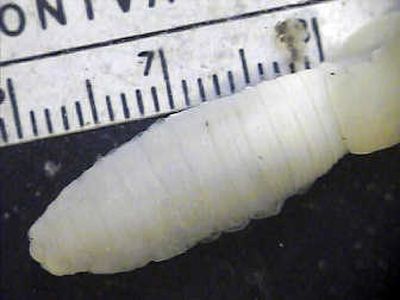Groups suing to protect big worm

A giant, rare earthworm from the Palouse prairie is inching its way to court.
Environmental groups contend the federal government has ignored their requests for Endangered Species Act protection for the worm, which grows to a yard long, is thick as a finger and is known to spit lily-scented juices at attackers.
The pale worm has only been spotted four times in the last generation – most recently in 2005, when a University of Idaho graduate student accidentally chopped one in half while using a shovel to conduct research on one of the last remaining stretches of native Palouse prairie in southeastern Washington.
The sighting and subsequent failure to unearth additional specimens – numerous worm safaris came back empty-handed – prompted calls a year ago for the U.S. Fish and Wildlife Service to extend emergency Endangered Species Act protections for the worm and its habitat. The agency responded by saying there was not enough money to look into the issue, said Steve Paulson with Friends of the Clearwater.
“We don’t know if it’s going to make it to the Endangered Species Act or not, but the law requires them to find out,” Paulson said of the Fish and Wildlife Service. “It’s their job.”
On Monday, a coalition of environmental groups filed notice that it intends to sue the Fish and Wildlife Service for failing to respond to their listing petition. The groups include Friends of the Clearwater, Center for Biological Diversity, Palouse Prairie Foundation and the Palouse Audubon Society.
The Fish and Wildlife Service had no immediate comment on the pending suit, according to Tom Buckley, a spokesman in the agency’s Spokane office.
Listing would also require support from the U.S. Congress. A spokesman for Rep. Bill Sali, the Idaho Republican whose district includes the worm’s habitat, had no comment Monday.
Early settlers to the Palouse described the giant earthworms as “very abundant,” according to historical records kept by the Palouse Prairie Foundation. Road construction crews noted the creature’s wide burrows, which were nearly two stories deep.
The worms spend the heat of the summer underground, but they come to the surface to feed, according to a previous interview with William Fender, who traveled from Portland to the Palouse last year to search for the worm. These feeding jaunts also put the long worm in contact with steel plow blades.
According to Paulson, 99 percent of the Palouse prairie has been plowed, bulldozed or otherwise developed. The worm, he said, “is a representative for the Palouse prairie habitat that is practically gone and has no protection whatsoever.”
Endangered Species Act protection would make it more difficult to develop the remaining native prairie, including a proposed rerouting of a state highway, Paulson said. Listing would also unleash additional federal research and recovery dollars.
“This worm is the stuff that legends and fairytales are made of. What kid wouldn’t want to play with a three-foot-long, lily-smelling, soft pink worm that spits? A pity we’re losing it,” Paulson said, in a written statement.
Paulson said four law firms have offered to help with the worm’s legal case. “There’s a lot of support for this worm,” he said.
Although the Endangered Species Act has been used to protect beetles, salamanders, snails and mussels, no known full-time soil-dwellers are on the list, said Noah Greenwald, a conservation biologist with the Center For Biological Diversity. The worm might live out of sight, but that doesn’t make its survival less important, he said.
“Let’s face it, the soil is the foundation of our society. What happens underground is key to our existence,” Greenwald said.
But Greenwald thinks avoidance of the worm listing has nothing to do with science. Since President Bush took office, just 58 species have been added to the list, compared with 522 species under Bill Clinton and 231 during the first Bush presidency.
“That’s fairly typical under the Bush Admnistration. Even though they have these clear timelines, they just never get to it,” Greenwald said.